
9 月 . 18, 2024 12:13
Back to list
pneumatic control valve
Pneumatic Control Valves Essential Components in Modern Automation
Pneumatic control valves are critical components in various automated systems, playing a vital role in the regulation of air pressure, flow rate, and direction of air in pneumatic systems. These valves are designed to control the operation of actuators, such as cylinders or motors, which are utilized in a wide range of applications across many industries including manufacturing, automotive, robotics, and more.
At the heart of pneumatic systems, control valves manage the flow of compressed air, which serves as the power source for pneumatic devices. The basic operation of a pneumatic control valve involves an actuator mechanism that opens or closes the valve based on the signals received from a control system. These signals can be manual or automated, depending on the complexity and design of the entire system.
One of the key advantages of pneumatic control valves is their ability to provide precise control over various operational parameters. By adjusting the flow rate, pressures, and direction of air, these valves allow for enhanced performance and efficiency in pneumatic systems. For instance, in a manufacturing setting, pneumatic control valves can facilitate the precise operation of robotic arms, significantly increasing production speed and accuracy.
There are several types of pneumatic control valves, each designed to serve specific functions. The most common types include on/off valves, flow control valves, pressure relief valves, and directional control valves. On/off valves, as the name suggests, simply allow or block the flow of air, while flow control valves manage the speed of actuators by regulating the air passage. Pressure relief valves play a critical safety role by preventing pressure build-up within the system, and directional control valves direct the flow of air to different parts of the system based on operational needs.
pneumatic control valve

The selection of a pneumatic control valve depends on various factors, including the operational requirements, the nature of the application, and environmental conditions. Key considerations include the flow rate, pressure ratings, and the specific functions required from the valve. Additionally, materials and build quality are essential to ensure durability and reliability, particularly in harsh working environments.
Maintenance of pneumatic control valves is equally important to ensure their longevity and proper functioning. Regular inspection for leaks, wear, or damage is crucial, along with keeping the valves clean from contaminants that could hinder their operation. A well-maintained valve contributes significantly to the overall efficiency and effectiveness of the pneumatic system.
Innovation in pneumatic control valve technology continues to evolve, with advancements aimed at increasing energy efficiency and reducing environmental impact. The integration of smart technologies and automation allows for enhanced monitoring and control, further optimizing system performance.
In conclusion, pneumatic control valves are indispensable in today’s automated industries, providing crucial control over air flow and pressure. Their versatility and efficiency make them ideal for a wide range of applications, driving innovation and productivity across various sectors. As technology progresses, the importance of these valves is expected to grow, making them vital components in the next generation of automation systems. Whether in manufacturing, robotics, or any other field relying on pneumatic systems, understanding and utilizing pneumatic control valves is essential for success.
Next:
Latest news
-
Unlocking The Quality Gas Pressure ReducersNewsNov.01,2024
-
The Role of Gas Pressure Reducing StationsNewsNov.01,2024
-
The Importance and Functionality of Safety Relief ValvesNewsNov.01,2024
-
The Essential Role of Safety Valves in Natural Gas ApplicationsNewsNov.01,2024
-
The Essential Role of Gas Pressure RegulatorsNewsNov.01,2024
-
Enhance Your Premium Gas FiltersNewsNov.01,2024

